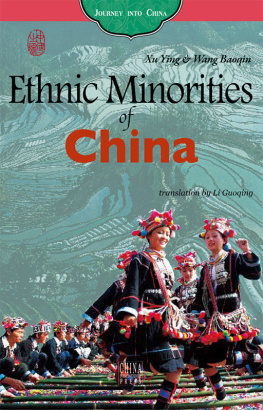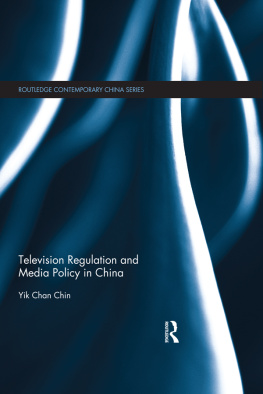TWO BILLION EYES
Also by Ying Zhu
Chinese Cinema During the Era of Reform:
The Ingenuity of the System (2003)
Television in Post-Reform China:
Serial Dramas, Confucian Leadership
and the Global Television Market (2008)
TWO BILLION EYES
The Story of China Central Television
Ying Zhu

2012 by Ying Zhu
All rights reserved.
No part of this book may be reproduced, in any form, without written permission from the publisher.
Requests for permission to reproduce selections from this book should be mailed to: Permissions Department, The New Press, 38 Greene Street, New York, NY 10013.
Published in the United States by The New Press, New York, 2012 Distributed by Perseus Distribution
LIBRARY OF CONGRESS CATALOGING-IN-PUBLICATION DATA
Zhu, Ying, 1965
Two billion eyes : the story of China Central Television / Ying Zhu.
p. cm.
Includes bibliographical references and index.
ISBN 978-1-59558-802-9 1. Zhong yang dian shi tai (Beijing, China) 2. Television broadcastingChina. 3. Television broadcasting policyChina. I. Title. PN1992.3.C6Z484 2012
384.55'4550951dc23
2012010091
Now in its twentieth year, The New Press publishes books that promote and enrich public discussion and understanding of the issues vital to our democracy and to a more equitable world. These books are made possible by the enthusiasm of our readers; the support of a committed group of donors, large and small; the collaboration of our many partners in the independent media and the not-for-profit sector; booksellers, who often hand-sell New Press books; librarians; and above all by our authors.
www.thenewpress.com
Composition by dix!
This book was set in Minion
10 9 8 7 6 5 4 3 2 1
To my family
CONTENTS
When approached to write a book on China Central Television, I thought the idea intriguing but challenging. Access would be one formidable obstacle. To this end, several prominent individuals who wish to remain anonymous came to my aid. My first thank-you goes to them. Further along, Professor Lu Xinyu of Fudan University, Professor Lei Jianjun of Tsinghua University, and Professor Huang Shixian of Beijing Film Academy provided a road map as I navigated the complex terrain of CCTV. Initial field research for the book was done in China in the summer of 2008, courtesy of an American Council of Learned Societies Fellowship, which was jointly funded by the National Endowment for the Humanities. I wish to mention that an NEH fellowship in 2006 made it possible for me to initiate my research on Chinese television, which eventually led to this book. Frances Hisgen, my then nine-year-old daughter, was a loyal companion during our chaotic six-month sojourn in Beijing. Her intellectual curiosity and moral compass kept me on my toes. A PSC-CUNY Research Award provided funding for my additional trips to Beijing, on one of which I was joined by John Jirik, a fellow traveler who accompanied me to a couple of interviews and who graciously shared with me his solo interview with Jiang Heping. I wish to thank all the CCTV practitioners with whom I had the pleasure of engaging in candid dialogue about China and Chinese media. My hearty appreciation goes to Jason Ng, my editor at The New Press, who initiated this book and provided thoughtful feedback and thorough editing. Together with Jasons enthusiasm and dedication, I am grateful for the patience and faith of Marc Favreau, The New Presss editorial director, who tolerated a prolonged process as I struggled to bring the book to its completion. Sarah Fans efficiency during the production process prevented further delay. Julie McCarroll, the publicity director at The New Press, has been instrumental in bringing this book to wide attention. The book benefited from Bruce Robinsons editorial and intellectual inputs during the early stage of writing and from Michael Keanes efficiency for tidying up during the final stage of writing. Both Bruce and Michael generously shared with me their ideas, phrases, and passages, some of which I shamelessly and seamlessly blended into this book. I thank Stanley Rosen and Stephanie Donald for being my cheerleaders on various fronts. My brief acknowledgment here does not pretend to do justice to all the individuals whose contributions made this book possible.
TWO BILLION EYES
Just before 2:30 P.M. local time on May 12, 2008, an earthquake measuring 8 on the Richter scale hit Sichuan Province. I was alone in my Beijing apartment that afternoon and felt a slight shake. To confirm that I wasnt imagining things, I called a friend to ask if she felt anythingI wasnt. In another day and age, my next response might have been to head to the street and await instructions, but today, information comes much faster online, and it was there that I read the initial announcements about the earthquake. Another friend phoned to check in and tell me to tune in to China Central Television, which was reporting on the disaster with a rolling ticker. In fact, CCTV began to broadcast news of the earthquake via rolling tickers within minutes of the quake, and by 3 P.M. it had reporters on the air with updates. By 3:20 P.M., the CCTV News Channel had prepared a special program, Exclusive Reports on Sichuan.
The swift media response was striking. In the past the Chinese media had generally shied away from instant coverage of natural disasters. Domestic disasters of any sort were considered too hot to handle without instruction from the state and could harm the national image. Disaster reporting had gradually become less of a taboo from the 1990s forward, yet up until the Sichuan earthquake, CCTV did not aim to be the fastest; instead it vowed to be the most correct in its coverage of such events. The networks flagship News Channel, CCTVs version of CNN, was established in May 2003 in response to complaints about the Chinese medias cover-up of the SARS epidemic. The News Channel started to offer a state-sanctioned release of SARS-related news bulletins, including information concerning prevention and treatment of SARS. Although envisioned partly as a platform for live coverage, the News Channels reporting on SARS was tentative and measured, following strict government guidelines, and in the years after, it continued the trend by confining its live reports mainly to planned events rather than breaking news. But things were dramatically different this time. Instead of waiting for guidance from above on how to report the earthquake, Chinese media from across the country, including CCTVs News Channel, took advantage of the scale of the disasterthis would be much harder to hide than an outbreak of a mysterious diseaseand allowed journalistic logic to prevail over party logic.
The speed and initial frankness of Chinese media reports from Sichuan were unprecedented, surprising everyone both at home and around the world. This surprise was especially keen in light of the fact that during the run-up to the Olympics, which opened a few months later in Beijing, the Chinese media had been tightly controlled and packaged by the government. The earthquake coverage was instantly recognized as a milestone in Chinese journalism and disaster reporting, and for a moment, the Chinese media appeared to break free of their assumed propaganda role.
In the immediate chaos of the quake, the Propaganda Department of the Communist Party of China (CCP) either recycled outdated control orders or was too rushed to issue detailed instructions on appropriate news coverage. Leaked reports suggested that the Propaganda Department was initially shocked and disoriented, and it was only hours later that an order was issued to Chinese news organizations not to send reporters to the scene, but instead to use only information released by either CCTV or the Xinhua News Agency, the official press agency of the state.
Next page







